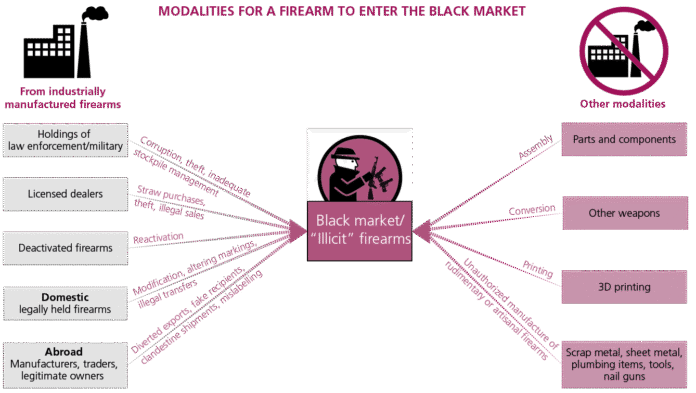The Current Landscape of Illicit Small Arms
The proliferation of illicit small arms and light weapons presents a profound challenge to global security. Currently, it is estimated that over 1 billion firearms are in circulation worldwide, fueling conflicts, crime, and instability. This staggering figure illustrates the extent to which these weapons have permeated both legal and illegal markets. The presence of such an expansive arsenal exacerbates existing tensions and creates new security threats, thus demanding urgent attention from the international community.
One critical factor contributing to this alarming trend is the significant levels of military spending observed in many nations. Funds that could otherwise be allocated for essential services such as education and healthcare are frequently diverted to bolster military capabilities. This increase in military expenditure not only intensifies the demand for advanced weaponry but also often results in surplus arms being funneled into illicit markets. Furthermore, the proliferation of these weapons is sustained by robust trafficking networks that operate across borders, moving arms from regions of surplus to areas marked by conflict and instability.
Technological advancements play a crucial role in the landscape of illicit small arms. The advent of more efficient production techniques has made it easier for illicit manufacturers to produce firearms clandestinely, further saturating markets. Additionally, the rise of digital platforms has facilitated the online trade of illicit arms, allowing traffickers to circumvent traditional distribution channels and reach potential buyers with relative anonymity.
The global consequences of the illicit arms trade are profoundly negative. The availability of small arms contributes significantly to violence, enabling terrorist groups, organized crime syndicates, and militias to operate with increased lethality. This cycle of violence not only poses an immediate threat to affected communities but also has far-reaching implications for international peace and security, underscoring the pressing need for coordinated global action to address this critical issue.
The Root Causes and Consequences of Proliferation
The proliferation of illicit small arms poses significant challenges and brings dire consequences to global stability and security. One of the primary concerns is the severe violation of arms embargoes, particularly in conflict zones such as Libya, Yemen, and Haiti. In these regions, the lack of regulation and oversight allows for an influx of unauthorized weapons, fueling violence and prolonging conflicts. Such violations not only undermine peace efforts but also exacerbate humanitarian crises, as armed groups gain access to tools that enable them to commit atrocities against civilians.
Moreover, the rise of new technologies presents additional challenges in the fight against small arms proliferation. The advent of 3D printing has made it possible for individuals to manufacture weapons in a clandestine manner, significantly increasing accessibility on black markets. This technological shift allows actors with malicious intent to bypass traditional means of acquiring arms, threatening to escalate conflicts and create new security dilemmas globally. As a result, governments and international bodies face the urgent need to adapt their regulatory frameworks to counter these emerging threats.
The human cost associated with the misuse of small arms is staggering. Civilians often bear the brunt of violence stemming from armed conflicts, with small arms being responsible for a significant number of deaths and injuries. The impact extends beyond immediate casualties; communities can suffer from long-term effects such as trauma, displacement, and loss of livelihoods. Effective governance plays a critical role in mitigating these issues, as weak state institutions often contribute to an environment where illicit arms purchases flourish. In regions like Haiti and various parts of Africa, the interplay between governance failures and the availability of small arms leads to broader instability, further complicating efforts aimed at peacebuilding and recovery. Addressing these root causes is essential to curbing the proliferation of illicit small arms and reducing their devastating impacts.
Regional and National Case Studies
The illicit small arms trade poses severe challenges across various regions, with consequences that resonate deeply within local societies. One significant illustration of this phenomenon is Haiti, where rampant gang violence has been exacerbated by the availability of illegal firearms. The country’s complex political landscape and socioeconomic issues create fertile ground for violent crime, leading to destabilization and severe repercussions for innocent civilians. As gangs vie for control over territories, the impact of illicit arms on public safety becomes increasingly profound, further entrenching a cycle of violence that is difficult to break.
In Africa, the challenges posed by unregulated borders complicate efforts to combat the illicit arms trade. Many nations face the dire consequences of small arms proliferation, which undermine governance and contribute to ongoing conflicts. Cross-border trafficking networks flourish, and armed groups exploit weak legal frameworks to obtain weapons. This pervasive issue necessitates a coordinated effort among African nations to institute stronger border controls and regulatory frameworks aimed at reducing arms flow into conflict zones.
The Democratic Republic of the Congo (DRC) exemplifies the chaos precipitated by arms trafficking, where local militias and armed groups perpetuate violence against civilians, driven by control over natural resources and territories. The influx of illegal firearms further fuels this instability, complicating humanitarian efforts and peacebuilding initiatives. Meanwhile, the situation in Ukraine highlights the geopolitical dimensions of illicit arms trade, as the ongoing conflicts have resulted in significant weapon trafficking, which poses a threat not only to regional stability but also to global security.
Conversely, Colombia presents a case study of progress amidst adversity. The nation has faced extensive challenges with illicit arms linked to drug trafficking and insurgency groups. Nevertheless, Colombia’s commitment to disarmament and peace negotiations has led to significant reductions in armed violence. Through comprehensive policies aimed at addressing root causes and engaging communities in disarmament efforts, Colombia serves as an illustrative model of how nations can confront the overwhelming threat posed by the illicit arms trade.
Strategies for International Cooperation and Action
The proliferation of illicit small arms poses a significant threat to global security, demanding coordinated efforts on an international scale. A crucial starting point in addressing this issue lies in the strengthening of existing frameworks, such as the UN Programme of Action on Small Arms and the Arms Trade Treaty. These agreements serve as foundational instruments for fostering cooperation among member states, establishing standardized controls, and promoting transparency in the arms trade. Enhancing compliance mechanisms within these frameworks can ensure that nations adhere to their commitments, thereby mitigating risks associated with the unauthorized transfer of small arms.
Furthermore, the rapid advancement of technology presents both opportunities and challenges in the realm of arms regulation. Emerging technologies can streamline the monitoring of arms transfers and improve traceability; however, they can also enable the illicit production and distribution of small arms. Addressing these challenges requires innovative solutions, including the development of comprehensive guidelines that incorporate technological advancements into existing regulatory frameworks. International collaboration is essential in creating a response that is dynamic and adaptable to these evolving scenarios.
Capacity-building initiatives for post-conflict states play a pivotal role in preventing the resurgence of armed violence fueled by small arms. These efforts should focus on strengthening governance structures, enhancing border security, and promoting disarmament campaigns. Additionally, addressing the root causes of instability, such as poverty and political disenfranchisement, is vital in creating an environment less conducive to the proliferation of arms.
Each member state’s position on arms trade and regulation varies, influenced by a multitude of factors, including national security interests and economic considerations. A collective approach that acknowledges the diverse perspectives of nations while fostering open dialogue can lead to more robust cooperation. By emphasizing a united effort that encompasses a multifaceted strategy—a combination of enhanced regulatory frameworks, technological integration, and capacity-building—global actors can effectively combat the spread of illicit small arms and work towards a more secure future.

